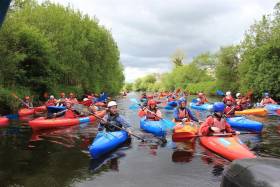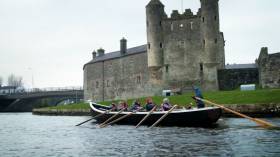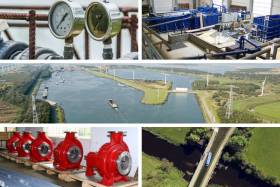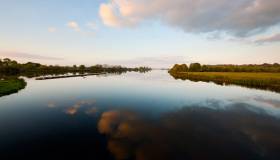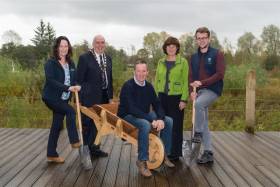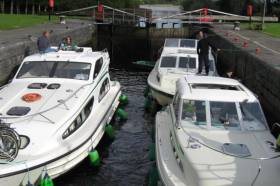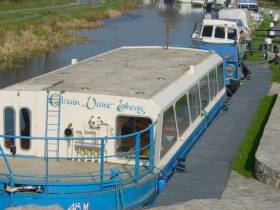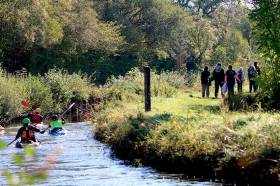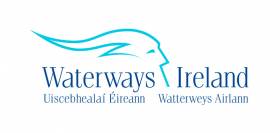Displaying items by tag: Waterways Ireland
Waterways Ireland Issues Notice Of Ban On Green Diesel For Personal Pleasure Craft From January 2020
Waterways Ireland has issued a notice for masters and owners of vessels that the Department of Finance intends changing the law regarding the use of marked gas oil, or MGO, in private pleasure craft from 1 January 2020.
The change follows the recent EU ruling against Ireland regarding the use of MGO — colloquially 'green diesel' — on pleasure craft.
The Department of Finance will propose an amendment to the Finance Act 2019, and once the amendment is enacted, the use of MGO as a propellant by private pleasure craft will be illegal. The practical repercussions of this are that private pleasure craft will need to use standard auto diesel as a propellant.
EU Directive 2003/96 defines “private pleasure craft” as “any craft used by its owner or the natural or legal person who enjoys its use either through hire or through any other means, for other than commercial purposes and in particular other than for the carriage of passengers or goods or for the supply of services for consideration or for the purposes of public authorities.”
In simple terms, the change to the law means that private and hired pleasure craft operating in the Republic of Ireland must use auto diesel from 1 January 2020. Commercial and public authority craft are exempt from the requirement.
Waterways Ireland says further information can be obtained from the Office of the Revenue Commissioners.
Applications Now Open For Waterways Ireland’s 2019 Events Programme
#InlandWaters - The Waterways Ireland Events Programme is now open for 2019 and welcomes applications from inland waterways and waterside communities seeking support to start and grow sustainable events.
Taking place annually for the past 13 years, the programme has supported competitions, learning experiences, community, historical and educational events for people with and without disabilities across thousands of communities nationwide.
Involving angling, canoeing, rowing, sailing and power sports, arts, history, drama and learning new skills, these events have most importantly been about having fun on the waterways under the auspices of Waterways Ireland, the recreation and navigation authority for the Barrow Navigation, Erne System, Grand Canal, Lower Bann Navigation, Royal Canal, Shannon-Erne Waterway and the Shannon Navigation.
“The new vision for the event programme will activate event organisers to consider how they can build in ongoing activity and sustained use of the waterways corridors into their event,” says Sharon Lavin, head of marketing and communications with Waterways Ireland.
“Tourism and participation in recreation has a social and economic impact in waterfront communities, and events are a great way to engage communities with previously under-utilised waterways.”
The application form and guidance notes can be viewed and completed online. Terms and conditions apply. The closing date the receipt of completed applications is Wednesday 16 January.
Waterways Ireland Shares Video ‘Stories From The Waterways’
Waterways Ireland’s YouTube channel is this week featuring a series of ‘Stories from the Waterways’ highlighting various community groups and cottage industries that have made the most of their local environment close to Ireland’s canals, lakes and rivers.
The first short film brings to life the work of Row the Erne, a group of experienced and novice rowers that meets every Saturday to row a traditional curragh built by the community themselves.
In Pollagh, Co Ofally, the Devery family tell the story of how the Grand Canal spurred the development of a brick-making industry, the skills from which survive to this day.
In Co Meath, the Ribbontail Padders comprises a group of families who took over an old lockkeeper’s cottage as a base from which to provide canoeing lessons on the Royal Canal.
And on the Lower Bann, joiner Bradden Braillie of the Portna Workshop talks through some of the vital work required to maintain the infrastructure of Ireland’s inland waterways, especially when dealing with technology such as original lock gates that could be hundreds of years old.
For a different perspective of the waterways, ‘river view’ images from this past summer’s Google Trekker survey of the River Shannon is now live on Google Maps.
In conjunction with Waterways Ireland, the Google Trekker Loan Programme toured from Lough Allen to Loop Head gathering data for what amounts to “the first such water-based collection of imagery on the island of Ireland”.
Waterways Ireland Partners With European ‘Green WIN’ Project
Waterways Ireland is involved with the European project Green WIN, which aims to address excess energy use and high carbon emissions generated by pumping equipment and systems to keep waterways operational.
This project is funded under Priority 2 ‘Low Carbon’ of the European Regional Development Fund Interreg North-West Europe 2014-2020 and is led by Canal and River Trust (UK).
The other project partners are Ministerie van Infrastructuur en Waterstaat (NL), Université of Liège (BE), Voies Navigables de France (FR) and Vlaamse Landmaatschappij (BE).
The project aims to use trials of low-carbon water pumping technologies, systems or processes to show north-west European water management organisations how energy consumption and CO2 emissions for such operations can be significantly reduced.
From these trials, and by demonstrating a methodical approach that can be used after the project is complete, Green WIN aim to achieve 15% energy savings and CO2 reductions at 11 trial sites in Ireland, the UK and France by 2021, reducing energy use by 778,000 kWh and CO2 emissions by 195 tonnes.
Main outputs and pilots will be an infrastructure audit, technology trials, investment, procurement and business planning guidelines (a Greener Pumping Technologies Toolkit) and an established support network.
Green WIN will roll these out to other water management organisations by encouraging them to carry out new installations as their existing equipment reaches end of life.
The project will also aim to influence change in behaviours as well as legislation to reach a greater take up of greener technologies, lower energy usage, reduced emissions and more organisations involved in taking forward the technologies demonstrated in the project.
For more information on the project, visit the GreenWIN website.
#InlandWaters - Waterways Ireland advises that the electricity supply to power pedestals and the supply of water to taps on public moorings on the Shannon Navigation will soon be disconnected for the winter period.
The move is being made for environmental reasons and to reduce maintenance costs. Services will be restored prior to the commencement of the 2019 boating season.
Shore power supply at the Round ‘O’ and Carrybridge public moorings on the Erne System, as well was water supply to taps throughout that system, was already disconnected or winter as of Wednesday 7 November.
Handcrafted Tools Bring Royal Canal’s History to Life
#InlandWaters - Tools created by local Fermanagh craftsperson Albert Robinson were a key feature during this year’s World Canals Conference.
The tools, displayed in archive exhibition ‘Reflections, the Lasting Legacy of the Waterways’, brought to life the story of the strong men who powered the construction of Ireland’s canals system over 200 years ago.
Commissioned by the Directors General of Inland Navigation in 1813, the final section of the Royal Canal in Ireland to connect with the Shannon River was an extraordinary feat of ingenuity, engineering and sheer hard labour.
The contract to build the canal — complete with 21 locks, an aqueduct, 38 bridges, 40 tunnels, and numerous quays and harbours — was undertaken by Henry, Mullins and MacMahon in 1814 under the direction of the pre-eminent Irish engineer of that time, John Killaly.
Remarkably, that final section was completed within three short years at a cost of £198,110, covering a distance of some 24 1/2 miles.
What is most striking is that the tools available to the canal builders at this time, the world-famous ‘navvies’, were so basic.
Under the building contract, a detailed design specification was prepared for the manufacture of these tools to the company standard.
Local man Albert Robinson, a carpenter with Fermanagh and Omagh District Council, meticulously recreated these tools – a hand barrow and a wheelbarrow – using the specific wood types, elm for strength and ash for flexibility.
Patterson’s Spade Mills, owned and run by the National Trust, is the last remaining spade mill in daily use in Britain and Ireland. They, too, faithfully recreated objects from the original drawings, producing a spade and shovel.
The tools were on display throughout the World Canals Conference — which attracted over 320 delegates from 12 countries across three continents over its three days last month — and provoked much positive comment and requests for further displays of this quality work.
Commenting on the unique collection of handcrafted tools, Dawn Livingstone, chief executive of Waterways Ireland, said: “Working in partnership with Fermanagh & Omagh District Council and the National Trust, we have brought back to life a remarkable era of canal construction and created objects that tell the story of the men who built the amazing waterways that we continue to enjoy today.
“I commend the skill of the craftspeople involved from Fermanagh & Omagh District Council and Patterson's Spade Mill and would encourage visitors to see this extraordinary collection for themselves.”
Speaking about the exhibition, chairman of Fermanagh and Omagh District Council, Councillor Howard Thornton, said: “I am tremendously impressed by the craftsmanship shown by Albert in the recreation of the tools used in the construction of the final section of the Royal Canal.
“Albert’s ingenuity and craftsmanship have often been utilised in his work with Fermanagh and Omagh District Council and I am delighted that his talent has been showcased to a wider audience at such a prestigious event.”
Nathan Domer, visitor experience officer with the National Trust, added that “this type of project is at the forefront of our core aims as a charitable organisation to conserve our heritage on land and on water for all to enjoy for ever, for everyone."
The tools and the original blueprint drawings in the exhibition can be viewed at Waterways Ireland HQ at 2 Sligo Road, Enniskillen weekdays from 9.30am to 5.15pm till Friday 9 November.
Waterways Ireland Website Launches New Corporate Social Media
#InlandWaters - This week Waterways Ireland has launched new corporate pages on Facebook and Twitter.
The social media accounts draw together all the messages around marine notices, job vacancies, construction works, corporate events and public consultations into a single location where interested parties can more easily find the information they need.
Waterways Ireland Notifications is the page name for both Facebook and Twitter.
All the posts will link back to the Waterways Ireland website where further detail, application forms, and options to participate will be more fully explained.
The current Waterways Ireland Facebook and Twitter pages “will continue to promote the enjoyment, scenic beauty, leisure travel and activities that form the pre-eminent experiences that bring waterway communities to life,” the cross-border agency says.
#HistoricBoats - Waterways Ireland is seeking tenders to restore a legacy canal barge as an office space for Dublin’s Silicon Docks.
According to the tender document, Waterways Ireland intends to clean out the vessel, further inspect its structural condition and convert it into “an open plan office for 6 workers with galley, meeting room and WC”.
The vessel would be moored at Grand Canal Basin alongside other similar floating work spaces.
It will also be self-propelled to enable it to move to other locations within the inland waterways network, and as such a P2 passenger boat licence will be required.
The Heritage Boat Association has more details on the barge, which was extensively rebuilt in at Shannon Harbour in a community project from 1996 to 2003 and renamed Cluaine Uaine Bheag.
Originally built as a general motorised trade boat by Vickers for the Grand Canal Company in 1928, the barge – then known as 48M – would have carried Guinness and other cargo until the canal’s commercial closure in 1959.
#InlandWaters - Waterways Ireland has welcomed last week’s launch of the National Greenways Strategy by Tourism Minister Shane Ross.
The strategy sets out how national and regional greenways in Ireland should be planned and constructed, and is backed by a fund of €53 million for the years 2019 to 2021.
“I am delighted to be launching this strategy today in our Hidden Heartlands,” Minister Ross said last Friday 20 July, “That brand, and indeed our other tourism brands all identify activity tourism as a key sector for sustainably growing tourism numbers in Ireland.
This strategy, is, I know, eagerly awaited around the country. People have seen the benefits that have accrued to towns along our greenways to date, examples such as Newport on the Great Western Greenway, Kilmacthomas on the Waterford Greenway and here in Moate along the Old Rail Trail.
“Our goal is to replicate the success of those towns and those greenways in other locations around the country. That is why we are focussing our investment on projects of scale, the common denominator of successful projects to date is that they are in the order of 40km and thus provide the opportunity to overnight in a new area.”
The strategy sets out the importance of early and widespread consultation with landowners and communities along and adjacent to proposed greenway routes. It also emphasises the need to minimise the impact on landholdings by minimising severance as far as possible and providing accommodation works such as fencing and underpasses where required, and sets out the importance of access to scenery and things to see and do in order to attract tourists.
Brendan Griffinm Minister of State For Tourism, added: “We are lucky to live in such a beautiful country and greenways provide an opportunity to experience that beauty up close and at a slow pace.
“Our strategy will help us fund the spine of a network of greenways that can, over time, provide links to the rest of the countryside through quiet roads that will prove attractive to many people cycling. I know that Longford County Council is looking to identify a quiet route from the end of the Royal Canal Greenway in Clondra to Athlone; this will provide a wonderful triangular route from Mullingar along the Royal Canal to Clondra and then to Athlone returning to Mullingar on the Old Rail Trail.
“We must also remember that greenways are for more than people cycling. Statistics from our current greenways show that in towns such as Moate there are more people walking than cycling and the important health benefits that accrue to users are another huge benefit for our country.”
Minister Ross concluded: “I am looking forward to examining the many worthwhile project proposals that we expect to receive over the coming months under the funding call, and I would urge local authorities and state agencies to consult widely with landowners and communities along proposed routes to bring agreed routes to fruition. This strategy sets out how that consultation should take place and suggests the components that make for a successful greenway.”
#WaterSafety - Waterways Ireland has warned over the dangers of swimming and diving in and around navigation infrastructure such as bridges, locks, weirs, pontoons and harbour jetties.
The possibility of a swimmer being struck by a vessel, its propeller or being run over is ever present while powered craft are manoeuvring at such locations.
Swimming is therefore prohibited at these locations.
Waterways Ireland also advises all participants engaged in open water swimming training of the inherent dangers attached to this activity in locations where there is boating traffic.
A swimmer in the water wearing high visibility head gear will always remain a very small target to see to the master of a powered craft particularly if:
- the water surface is choppy
- there is strong glare reflected from the water surface
- there is difficulty in sighting due to slanting sunshine in early morning or late evening
- visibility is poor due to fog, mist or rain
Swimmers should risk assess their swimming location prior to entering the water, for boat traffic, entry and exit locations, availability of life saving appliances, weather and water conditions.
The presence of a safety boat or kayak will always give enhanced safety and security.
Earlier this week, two men lost their lives in separate incidents while swimming in Lough Derg on the Shannon Navigation, as previously reported on Afloat.ie.



























